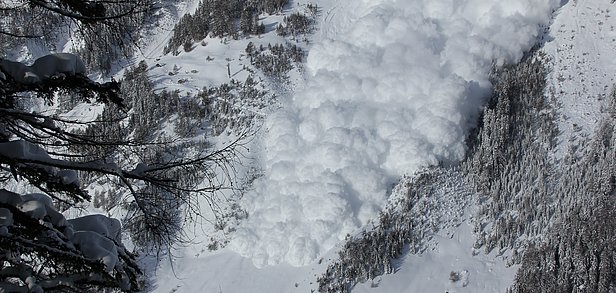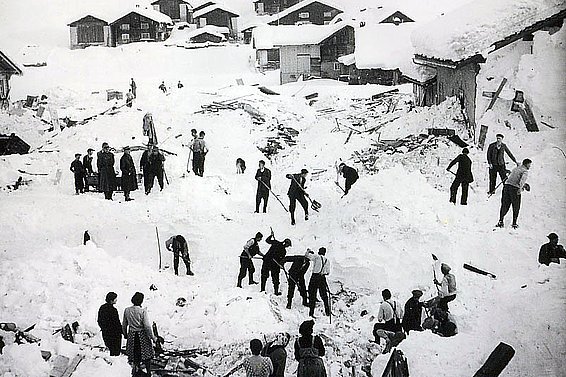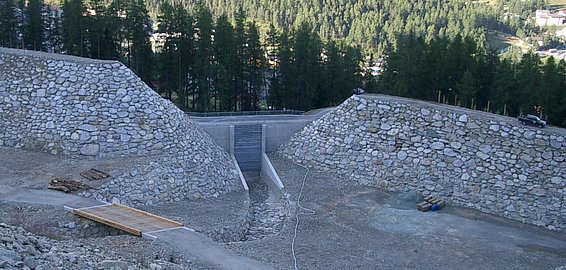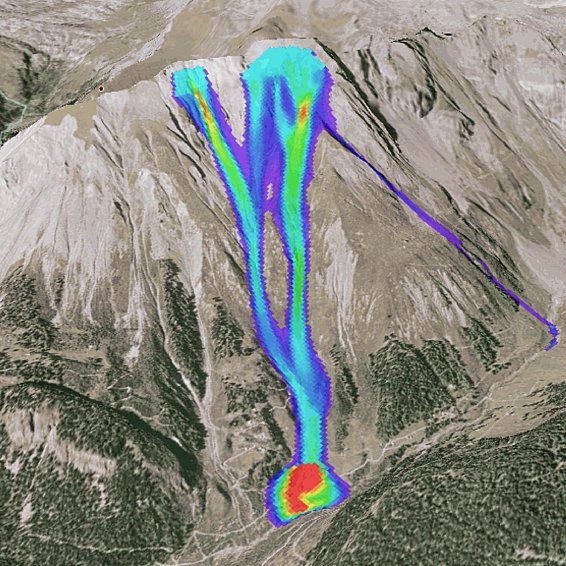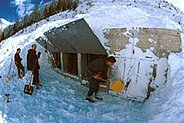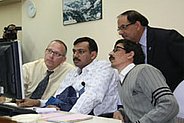Research into avalanche dynamics spans three generations ¶
Avalanche dynamics researchers investigate how avalanches move, how fast and how far they flow, the destructive forces they exert on objects in their path, and why they occur in such unusual forms, such as explosive clouds of powder snow (see Fig. 1).
The early days and the contribution of Adolf Voellmy ¶
Avalanche research in Switzerland began in the aftermath of the major avalanche disasters that occurred in the extreme winter of 1951. Numerous avalanches penetrated deep into the mountain valleys and destroyed whole sections of villages (see Fig. 2). Calls for a procedure capable of predicting how far avalanches travel became louder – mountain communities needed a decision-making tool so that they could designate specific areas as safe or unsafe. In 1955 the Swiss structural engineer Dr. Adolf Voellmy published a simple model of avalanche movement, which became known as the Voellmy model. In particular, it was based on his examination of the damage and destructive forces arising from the avalanches that obliterated the village of Blons in Vorarlberg, and other places, in 1954. His model was the first to describe the movement of an avalanche as a combination of solid and liquid flows. It proved so accurate that he was able to predict the damage that an avalanche would cause. To this day, his hypothesis remains among the most useful and enduring in the field of avalanche dynamics.
Bruno Salm and the mapping of avalanche danger zones ¶
The model developed by Voellmy to describe the flowing movement of snow did not in itself give rise to a procedure for calculating avalanche runout distances and terminal velocities. This shortcoming was resolved, but not until the early 1970s, by Dr. Bruno Salm, a structural engineer working for the SLF. He adopted Voellmy’s ideas and presented a calculation model that divided the avalanche path into starting, acceleration and runout zones. Each zone was characterised by its average slope angle. The model – which became known as the Voellmy-Salm model – enabled engineers, on the basis of a given fracture depth, to predict how far an avalanche would travel into the runout zone. They were also able to calculate the appropriate dimensions of retention and avalanche dams (Fig. 3), and delineate the red and blue zones on danger maps. A close examination of these maps after the major disasters in the winter of 1999 verified that they continue to serve their purpose well, even now.
The numerical models AVAL-1D and RAMMS ¶
The Voellmy-Salm model was created before computers made their way into engineering and planning offices. In the 1980s and 1990s, the rapid emergence of ultra-fast computers and numerical calculation models, and the ability to visualise graphics, gave rise to the first numerical avalanche dynamics programs. The SLF developed two of these programs, namely AVAL-1D and RAMMS, both of which were based on the Voellmy model. As numerical programs, however, they were able to describe the ground underlying the avalanche and the starting conditions much more realistically. AVAL-1D was developed for calculations in two-dimensional terrain and put to practical use in 1999, shortly after the dreadful winter. The much more advanced avalanche dynamics model RAMMS relies on data describing the three-dimensional topography, which these days is captured by laser scanners attached to helicopters (Fig. 4). Numerical models were the first to predict variable avalanche velocities and heights, as well as avalanche deposit patterns in the terrain.
Vallée de la Sionne ¶
In 1997 the SLF initiated construction of an extensive avalanche test site in Vallée de la Sionne (Fig. 5). Experiments conducted there have shown that multiple physical relationships exist within avalanches alongside those described by Voellmy and Salm. The motion sequences that occur in the frontal region of the avalanche, for example, differ markedly from those that occur at its end. The purpose of the measurements captured at the site remains unchanged, namely to review and continuously improve the calculation models by comparing their outcomes with actual large avalanches.
The future ¶
The research activities of the SLF in the field of avalanche dynamics now span three generations and have given rise to numerous application-related practical aids. Many of the outcomes are also being put to use abroad (Fig. 6). Members of the fourth generation of avalanche dynamics researchers are currently working on new models describing the different ways in which powder and wet snow avalanches move. These models are to be made available to avalanche practitioners in the near future.
